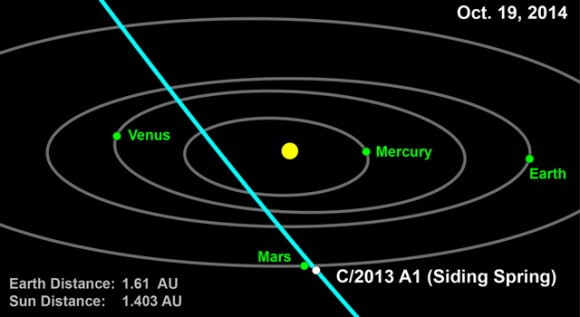Shortly after its discovery in December 2012, astronomers believed there was a chance, albeit small, that the newly discovered comet might be on a collision course with Mars. The odds were reduced from 1 in 8,000 to 1 in 120 thousand. It is now estimated that the shortest distance between the two bodies will be about 110 thousand kilometers
By Nancy Atkinson, Universe Today

NASA's Office of Near Earth Objects said this week that comet C/2013 A1 (Siding Spring) allowed them to refine the comet's trajectory and rule out the chances of it hitting Mars in October 2014. Shortly after its discovery in December 2012, astronomers believed that there was a chance, albeit a small one. , Because The newly discovered comet may be on a collision course with Mars.
The odds were reduced from 1 in 8,000 to 1 in 120 thousand. It is now estimated that the shortest distance between the two bodies will be about 110 thousand kilometers or 3 times the distance between the Earth and the Moon. This approach is expected to occur as mentioned on October 19, 2014 at 18:51 GMT. During the approach the comet will be on the side facing the Sun compared to Mars.
Comet Siding Spring was discovered in early 2013 by comet hunter Robert McNaught at the Siding Spring Observatory in New South Wales, Australia. When the discovery was made, astronomers at the Catalina Sky Scanner Observatory in Arizona looked back at their observations to find previous photographs of the comet that had not been identified as such. They discovered a photograph from December 8, 2012. These observations from December 8, 2012. These observations placed the direction of the comet's motion C/ 2013 A1 direct via Mars on October 19, 2014.
JPL states that future observations of the comet are expected to further refine the orbit calculation. For those interested, they can be tracked in the database of small bodies in the solar system at JPL.

3 תגובות
what is his size Isn't there some revolutionary possibility to instigate it from its orbit and make it collide with Mars? That way maybe he will cause the "earthing" of Mars.
dream.
What a mess! I was hoping that the comet would contribute a little to heating the cold planet and moistening it before we mobilized to drop a quarter of the Kuiper belt on it.
In any case, 110 thousand km is one third of the distance between Earth and the Moon, and not three times that.